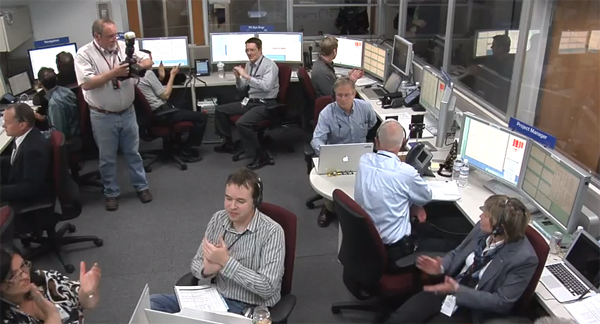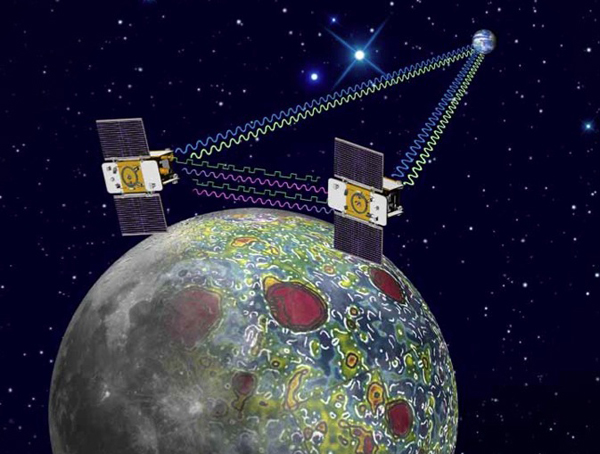Twin GRAIL spacecraft achieve lunar orbit (UPATED)
Editor's note...
CBS News
Ringing in the new year with back-to-back successes, a second NASA science satellite slipped into orbit around the moon Sunday, one day after an identical spacecraft braked into the same polar orbit for a $496 million mission to map the moon's interior by precisely measuring how its gravity affects the trajectories of the twin spacecraft.
Following programmed instructions, the second Gravity Recovery and Interior Laboratory -- GRAIL -- satellite fired its braking rocket at 5:05 p.m. EST (GMT-5), kicking off a 38.7-minute "burn" to slow the craft enough to let the moon's gravity capture it into an 11.5-hour orbit around the moon's poles.
"Cheers in JPL mission control as everything is looking good for GRAIL-B," NASA said in a Twitter posting after the rocket firing. "It's going to be a great 2012!!"
The identical GRAIL-A satellite arrived New Year's Eve. Over the next two months, both satellites will be maneuvered into circular 34-mile-high orbits before beginning three months of close-order formation flying to map the moon's gravitational field.
By precisely measuring the distance between the two spacecraft as they fly along -- and thus the subtle effects of the moon's gravity as they sail over visible and sub-surface geologic structures -- scientists will be able to determine the nature of the moon's enigmatic core and perhaps confirm or refute theories about how the moon formed at the dawn of the solar system.
"GRAIL's a journey to the center of the moon," Maria Zuber, the principle investigator, told reporters last week. "It'll use exceedingly precise measurements of gravity to reveal what the inside of the moon is like. And that information will be combined with the plethora of other remarkable observations of the moon that have been taken by satellites before and that are being taken right now (to) enable us to reconstruct the moon's early evolution."
Despite more than 100 missions to the moon, including six manned landings, Zuber said more is known about Mars than Earth's nearest neighbor. Major questions, she said before launch, include "is there a core? How did the core form? How did the interior convect? What are the impact basins on the near-side flooded with magma and give us this man-in-the-moon shape whereas the back side of the moon doesn't have any of this?"
"These are all mysteries that despite the fact we've studied the moon before, we don't understand how that has happened. GRAIL is a mission that is going to tell us that."
Along the way, it also may help inspire school kids to take more of an interest in science. Each satellite is equipped with four cameras sponsored by former shuttle astronaut Sally Ride's science education company that can be used by students around the world to photograph the lunar surface. Zuber said more than 2,100 schools had signed up to participate in the "Moonkam" program.
"Students, in collaboration with their teachers, will be able to look at where the trajectory of the two spacecraft are and then when the school's turn comes up they will be able to target images and then take their own images of the moon," Zuber said. "We've had a great response to the Moonkam project, we're still accepting applications. We can accommodate another several hundred schools into the program if there's interest in doing that."
The twin GRAIL spacecraft were launched from the Cape Canaveral Air Force Station in Florida on Sept. 10 atop a United Launch Alliance Delta 2 rocket. While a larger rocket could have boosted the satellites to their target in a matter of days, the less powerful Delta 2 kept costs down and gave flight controllers more time to activate, check out and calibrate the sensitive radio gear that will be used to precisely measure the distance between the spacecraft.
The so-called low-energy trajectory was set up to allow about a day between the arrival of GRAIL-A and GRAIL-B. Following programmed instructions, GRAIL-A's main engine fired at 4:21 p.m. Saturday, burning for nearly 40 minutes to slow the craft by some 427 mph and put it into the planned 11.5-hour elliptical orbit.
"Just because we're in lunar orbit doesn't mean we're good to go for the science phase," David Lehman, GRAIL project manager at NASA's Jet Propulsion Laboratory in Pasadena, Calif., said last week. "There's still work to be done. Following lunar orbit insertion, the spacecraft will perform a series of intricate burns that take about two months. These are required before we can get both spacecraft down to a 34-mile altitude. Once that's done, that's when the science for GRAIL can begin."
If all goes well, science operations will begin around March 8. Flying in formation at distances ranging from about 46 to 140 miles, the two spacecraft will send radio pulses and timing signals back and forth to precisely measure the distance between them.
Sailing over buried mass concentrations, craters, mountain ranges, basins and other geologic features, the satellites will ever so slightly speed up and slow down, one after the other. The ranging system is accurate enough to detect differences of as little as one micron, or the width of a red blood cell.
By carefully analyzing those changes, scientists can determine the distribution of mass within the moon to gain insights into its hidden interior structure and the nature of its deep interior.
The primary mission must be completed by early June when the solar-powered satellites will experience an extended eclipse. The spacecraft were not designed to survive that long without power, but Zuber said the systems are performing better than expected and it now appears an additional, extended mapping mission may be possible.
- Posted at 5:33 PM EST, 12/31/11: 1st GRAIL spacecraft brakes into lunar orbit; 2nd to follow suit Sunday
- Updated at 06:55 PM EST, 01/01/12: 2nd GRAIL satellite slips into orbit around the moon
CBS News
Ringing in the new year with back-to-back successes, a second NASA science satellite slipped into orbit around the moon Sunday, one day after an identical spacecraft braked into the same polar orbit for a $496 million mission to map the moon's interior by precisely measuring how its gravity affects the trajectories of the twin spacecraft.
Following programmed instructions, the second Gravity Recovery and Interior Laboratory -- GRAIL -- satellite fired its braking rocket at 5:05 p.m. EST (GMT-5), kicking off a 38.7-minute "burn" to slow the craft enough to let the moon's gravity capture it into an 11.5-hour orbit around the moon's poles.
"Cheers in JPL mission control as everything is looking good for GRAIL-B," NASA said in a Twitter posting after the rocket firing. "It's going to be a great 2012!!"
The identical GRAIL-A satellite arrived New Year's Eve. Over the next two months, both satellites will be maneuvered into circular 34-mile-high orbits before beginning three months of close-order formation flying to map the moon's gravitational field.
 |
| Flight controllers at the Jet Propulsion Laboratory in Pasadena, Calif., applaud as the GRAIL-A spacecraft braked into orbit around the moon Saturday. The identical GRAIL-B satellite followed suit Sunday. (NASA) |
By precisely measuring the distance between the two spacecraft as they fly along -- and thus the subtle effects of the moon's gravity as they sail over visible and sub-surface geologic structures -- scientists will be able to determine the nature of the moon's enigmatic core and perhaps confirm or refute theories about how the moon formed at the dawn of the solar system.
"GRAIL's a journey to the center of the moon," Maria Zuber, the principle investigator, told reporters last week. "It'll use exceedingly precise measurements of gravity to reveal what the inside of the moon is like. And that information will be combined with the plethora of other remarkable observations of the moon that have been taken by satellites before and that are being taken right now (to) enable us to reconstruct the moon's early evolution."
Despite more than 100 missions to the moon, including six manned landings, Zuber said more is known about Mars than Earth's nearest neighbor. Major questions, she said before launch, include "is there a core? How did the core form? How did the interior convect? What are the impact basins on the near-side flooded with magma and give us this man-in-the-moon shape whereas the back side of the moon doesn't have any of this?"
"These are all mysteries that despite the fact we've studied the moon before, we don't understand how that has happened. GRAIL is a mission that is going to tell us that."
Along the way, it also may help inspire school kids to take more of an interest in science. Each satellite is equipped with four cameras sponsored by former shuttle astronaut Sally Ride's science education company that can be used by students around the world to photograph the lunar surface. Zuber said more than 2,100 schools had signed up to participate in the "Moonkam" program.
"Students, in collaboration with their teachers, will be able to look at where the trajectory of the two spacecraft are and then when the school's turn comes up they will be able to target images and then take their own images of the moon," Zuber said. "We've had a great response to the Moonkam project, we're still accepting applications. We can accommodate another several hundred schools into the program if there's interest in doing that."
 |
| Radio ranging data will be used to precisely measure the distance between the two GRAIL spacecraft as they orbit the moon, helping scientists chart the lunar gravity field to map out mass concentrations beneath the surface. (NASA) |
The twin GRAIL spacecraft were launched from the Cape Canaveral Air Force Station in Florida on Sept. 10 atop a United Launch Alliance Delta 2 rocket. While a larger rocket could have boosted the satellites to their target in a matter of days, the less powerful Delta 2 kept costs down and gave flight controllers more time to activate, check out and calibrate the sensitive radio gear that will be used to precisely measure the distance between the spacecraft.
The so-called low-energy trajectory was set up to allow about a day between the arrival of GRAIL-A and GRAIL-B. Following programmed instructions, GRAIL-A's main engine fired at 4:21 p.m. Saturday, burning for nearly 40 minutes to slow the craft by some 427 mph and put it into the planned 11.5-hour elliptical orbit.
"Just because we're in lunar orbit doesn't mean we're good to go for the science phase," David Lehman, GRAIL project manager at NASA's Jet Propulsion Laboratory in Pasadena, Calif., said last week. "There's still work to be done. Following lunar orbit insertion, the spacecraft will perform a series of intricate burns that take about two months. These are required before we can get both spacecraft down to a 34-mile altitude. Once that's done, that's when the science for GRAIL can begin."
If all goes well, science operations will begin around March 8. Flying in formation at distances ranging from about 46 to 140 miles, the two spacecraft will send radio pulses and timing signals back and forth to precisely measure the distance between them.
Sailing over buried mass concentrations, craters, mountain ranges, basins and other geologic features, the satellites will ever so slightly speed up and slow down, one after the other. The ranging system is accurate enough to detect differences of as little as one micron, or the width of a red blood cell.
By carefully analyzing those changes, scientists can determine the distribution of mass within the moon to gain insights into its hidden interior structure and the nature of its deep interior.
The primary mission must be completed by early June when the solar-powered satellites will experience an extended eclipse. The spacecraft were not designed to survive that long without power, but Zuber said the systems are performing better than expected and it now appears an additional, extended mapping mission may be possible.